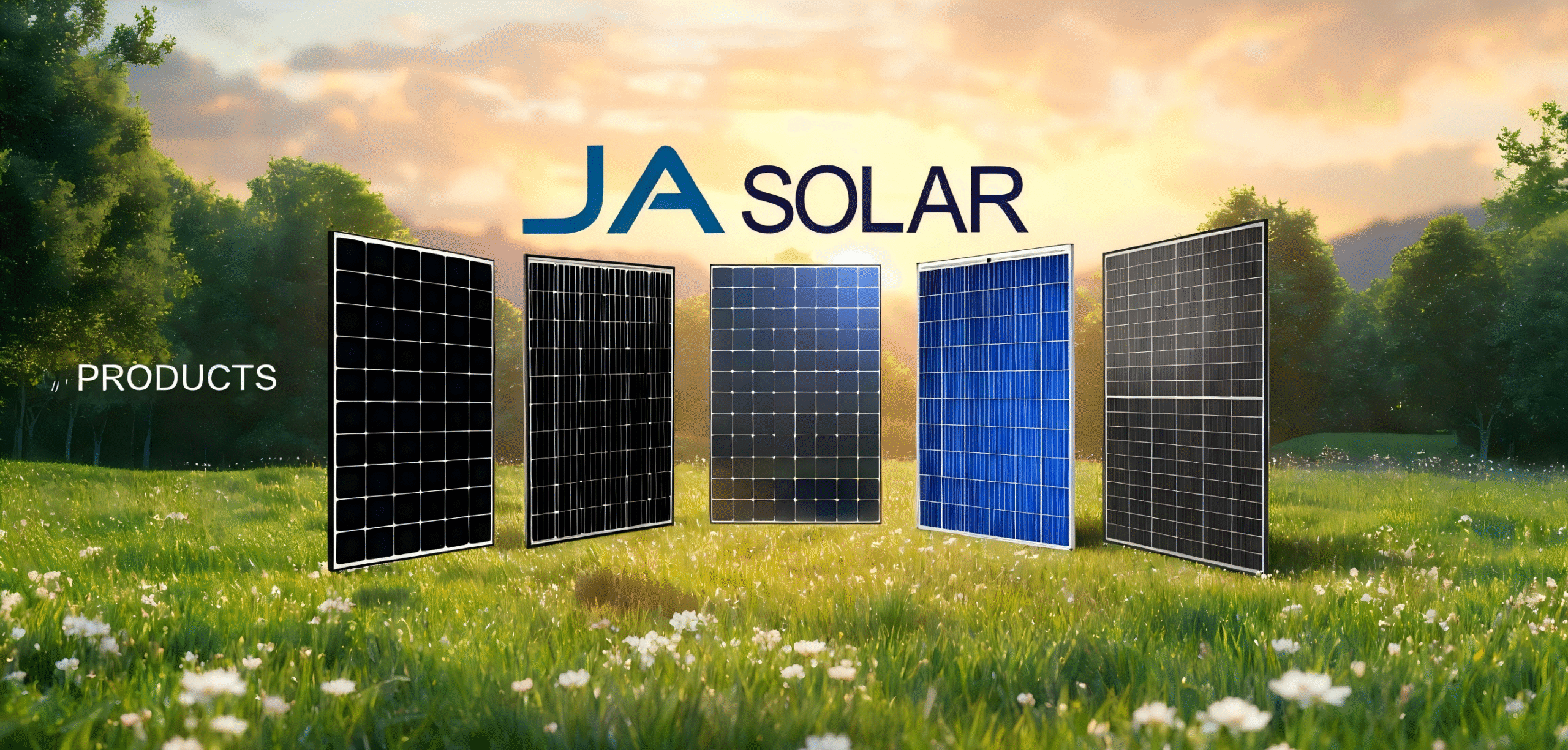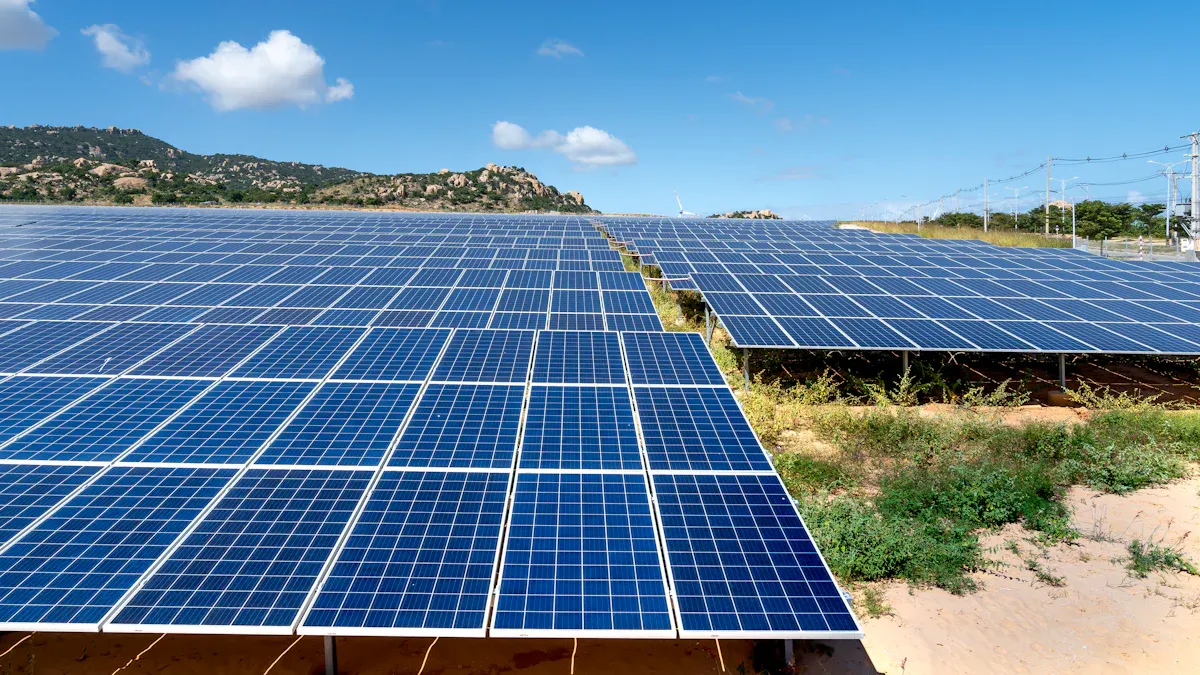

Choosing the right JA Solar PV panels for your solar project in 2025 starts with matching your selection to your roof’s type, available space, and age. The table below highlights how these factors influence system performance and longevity:
Factor | Impact on Performance and Longevity |
|---|---|
Roof Orientation | South-facing roofs deliver optimal solar output. |
Roof Size | Sufficient space allows for more panels and higher energy generation. |
Roof Age | Upgrading older roofs prevents future installation issues. |
Roof Material | Durable materials extend the lifespan of your solar system. |
You benefit from JA Solar PV’s high efficiency, reaching up to 21.5%, and robust durability with warranties up to 30 years. These panels maintain strong performance and minimize environmental impact. For personalized advice, Angsun solar provides expert support tailored to your needs.
Key Takeaways
Assess your roof type, orientation, and age to choose the right JA Solar PV panels for optimal performance.
Consider the efficiency of JA Solar panels, which can reach up to 23.4%, to maximize energy production in limited space.
Explore various panel options tailored for residential, commercial, and specialized applications to meet your specific needs.
Evaluate your budget carefully, factoring in installation costs and available incentives to make informed decisions.
Define clear energy goals, such as achieving net zero, to guide your selection of panel size and type.
Choose qualified installers with experience in JA Solar PV panels to ensure proper installation and warranty coverage.
Look for panels with strong warranties, like JA Solar’s 12-year product and 25-year performance warranties, for peace of mind.
Prioritize sustainability by selecting JA Solar, a company committed to reducing emissions and promoting eco-friendly practices.
JA Solar PV Strengths
Reputation
You want confidence in your investment, and JA Solar PV delivers that through a proven track record.
JA Solar stands as a leader in the global solar industry, recognized for strong market presence and reliable product performance.
The company’s reputation shines especially in Europe, where it maintains local warehousing and technical support.
JA Solar operates a fully integrated value chain, ensuring quality from manufacturing to delivery.
In 2025, the company expects to ship between 38 and 40 GW of modules, with products available in over 130 countries.
Industry rankings place JA Solar second among solar manufacturers, reflecting high trust and satisfaction among customers.
In the first quarter of 2025, JA Solar shipped 15.65 GW of cells and modules, with nearly half going to overseas markets. Most of these shipments featured advanced n-type modules, showing the company’s commitment to innovation.
Technology
You benefit from advanced technology when you choose JA Solar PV panels. The DeepBlue 3.0 series leads the way with high efficiency and innovative features. The table below compares JA Solar’s technology with other leading brands:
Brand | Technology Used | Key Features |
|---|---|---|
JA Solar | DeepBlue 3.0 series | High efficiency, advanced passivation, light-capturing technologies |
Jinko Solar | N-Type monocrystalline | Competitive efficiency and performance |
Trina Solar | Multi-busbar technology | Enhanced energy output and reliability |
Longi Solar | PERC technology | Improved efficiency and cost-effectiveness |
JA Solar PV panels use advanced passivation and light-capturing technologies. These features help you maximize energy production, even in challenging conditions. You can trust that your solar system will perform reliably for years.
Options
You have a wide range of options with JA Solar PV panels, making it easy to match your project’s needs. The table below highlights how different applications benefit from specific panel features:
Application Type | Key Benefits |
|---|---|
Residential | High efficiency for compact roof spaces |
Commercial and Utility-Scale | Reduced installation costs |
Ground-Mount Solar Farms | Bifacial panels yield up to 25% more energy |
Agrivoltaics | Elevated mounting for farming |
Off-Grid and Hybrid Systems | Reduced system complexity |
You can select panels designed for residential rooftops, large commercial projects, or specialized uses like agrivoltaics. Bifacial panels offer higher energy yields, while off-grid options provide flexibility for remote locations. This variety ensures you find the right solution for your solar goals.
Project Needs
Roof Type
Selecting the right panels for your project starts with understanding your roof type. The structure and material of your roof influence installation methods, costs, and long-term solar system stability. You need to match your roof’s characteristics with the best mounting solutions for optimal performance. The table below outlines how different roof types affect the installation of JA Solar PV panels:
Roof Type | Installation Considerations |
|---|---|
Tile Roof | Brackets lift panels above the roof. Installation cost varies by tile material. |
Metal Standing Seam | Easy attachment using standing seams. No drilling required. Eco-friendly and durable. |
Tar and Gravel | Additional brackets may be needed to tilt panels. Installation can be more expensive than pitched roofs. |
Wooden Roof | Not suitable for solar panels due to fire safety concerns. |
You should consult with your installer to confirm compatibility between your roof and the mounting system. Metal standing seam roofs offer the easiest and most durable solution for solar panels. Tile roofs require extra care and specialized brackets. Wooden roofs are not recommended for solar installations.
Space
The available space on your roof determines how many panels you can install and how much solar energy you can generate. You need to measure the usable area and consider any obstructions, such as chimneys or skylights. Larger roof spaces allow you to install more panels, which increases your total energy output. If your roof has limited space, you should prioritize high-efficiency panels to maximize solar production. You can also explore creative layouts or consider bifacial panels for ground-mount systems if rooftop space is insufficient.
Tip: Always ask your installer for a custom layout plan. This ensures you use every inch of available space for the best solar performance.
Age
The age and condition of your roof play a critical role in the success and longevity of your solar installation. You want your roof to last as long as your panels, which typically perform well for 25 to 30 years. If your roof is old or in poor condition, you risk costly panel removal and reinstallation in the future. Consider these points before installing JA Solar PV panels:
Make sure your roof is in good condition and relatively new.
If your roof is nearing the end of its lifespan, replacement before solar installation is recommended.
Aim for a roof that will last at least as long as your panels, ideally 25 to 30 years.
Roofs older than 15–20 years may need replacement to avoid future issues.
You protect your investment and ensure consistent solar performance by addressing roof age and condition before installation.
Budget
You need to set a clear budget before you choose JA Solar PV panels for your solar project. Your budget will guide your decisions on system size, panel type, and installation options. Costs vary depending on whether you install panels for a home or a commercial building. The following tables show typical price ranges for residential and commercial solar installations in 2025, including equipment and labor:
Home Size | Total Cost (Before Incentives) | Cost After Federal Tax Credit |
|---|---|---|
Small (1,000-1,500 sq ft) | $7,950 – $16,500 | $5,565 – $11,550 |
Medium (1,500-2,500 sq ft) | $13,250 – $26,400 | $9,275 – $18,480 |
Large (2,500+ sq ft) | $21,200 – $39,600+ | $14,840 – $27,720+ |
Commercial Size | Cost per Watt (Before Incentives) | Total Cost Range (Before Incentives) |
|---|---|---|
Small (10-25 kW) | $2.30 – $2.80 | $23,000 – $70,000 |
Medium (25-100 kW) | $2.10 – $2.60 | $52,500 – $260,000 |
Large (100+ kW) | $1.80 – $2.30 | $180,000+ |
You should factor in incentives, such as the federal tax credit, which can lower your upfront costs. Larger systems often have a lower cost per watt, but require a higher initial investment. You need to balance your budget with your energy goals and the available space for panels. Ask your installer for a detailed quote that includes all equipment, labor, and potential incentives.
Tip: Request a breakdown of costs for panels, inverters, mounting hardware, and labor. This helps you compare options and avoid hidden fees.
Energy Goals
You must define your energy goals before you select JA Solar PV panels. Your goals will determine the system size, panel model, and installation layout. Some homeowners want to reach net zero, while others aim for partial offset of their electricity bills. Commercial projects may target maximum solar output or specific sustainability benchmarks.
Net zero requires enough panels to cover your annual energy use. You need to consider practical limits, such as roof area and architectural features. For example, window placements and non-uniform roof shapes can reduce the effective installation area.
Safety rules often require a 1.5-meter offset from the roof edge, which limits the number of panels you can install.
If you want to extend solar generation hours, horizontal single-axis tracking (HSAT) can help. This technology increases daily energy yield and improves overall performance.
You should choose cost-effective inverter sizing. A DC/AC ratio of 1.7 or 1.5 is common for maximizing system output.
Distributed solar systems and utility-scale plants need separate modeling. You must match system size and panel type to your specific energy targets.
You should work with your installer to model your expected solar output. This ensures you select the right JA Solar PV panels and system size for your needs. Clear energy goals help you maximize your investment and achieve reliable performance.
JA Solar PV Features
Efficiency
You want to maximize your solar investment, so you need to focus on panel efficiency. Efficiency measures how well panels convert sunlight into electricity. In 2025, solar panel efficiency continues to improve, but you must compare models carefully. JA Solar PV panels, such as the JAM66D42 MB, reach up to 23.4% efficiency. This places them among the top performers, although the industry average now stands at 24.8%. At least ten manufacturers offer panels rated at 23% or higher, so you have many choices for high-efficiency panels.
JA Solar PV panel (JAM66D42 MB) efficiency: 23.4%
Industry average efficiency in 2025: 24.8%
Number of manufacturers with panels rated 23% or higher: at least 10
High-efficiency panels help you generate more power from limited roof space. You benefit from lower energy bills and a faster return on investment. When you select JA Solar PV, you get reliable solar panel efficiency that meets the demands of modern homes and businesses.
Tip: Choose high-efficiency panels if your roof space is limited or if you want to maximize energy output for net zero goals.
Durability
You need panels that withstand harsh weather and environmental stress. JA Solar PV panels excel in durability, proven by rigorous laboratory and field tests. The table below shows how JA Solar panels perform under extreme conditions compared to other leading brands:
Test Type | Performance Criteria | Top Performers |
|---|---|---|
Less than 2% degradation after 2,000 hours at 85°C and 85% humidity | JA Solar, JinkoSolar, Longi Solar | |
Hail Durability Test | Class A grade if less than 1% power degradation after high kinetic impact testing | JA Solar, JinkoSolar, Longi Solar |
Potential Induced Degradation (PID) | Less than 2% degradation after 192 hours of voltage bias exposure | JA Solar, JinkoSolar, Longi Solar |
Static and Dynamic Mechanical Load | Less than 2.5% degradation after 1,000 cycles of mechanical load | JA Solar, JinkoSolar, Longi Solar |
Thermal Cycling | Less than 5% degradation after 600 cycles between -40°C and 85°C | JA Solar, JinkoSolar, Longi Solar |
Ultraviolet Induced Degradation | Less than 2% degradation after 220 kWh/m2 UV exposure | JA Solar, JinkoSolar, Longi Solar |
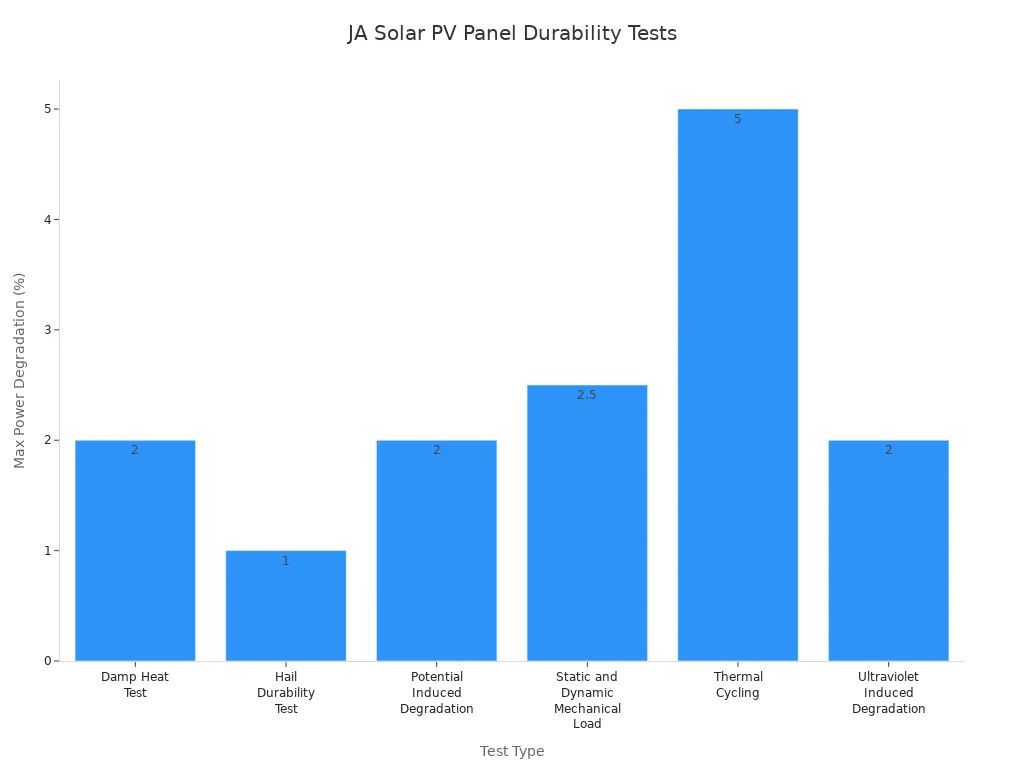
JA Solar PV panels maintain strong performance even after exposure to heat, humidity, hail, voltage stress, and mechanical loads. You can trust these panels to deliver reliable solar energy for decades. Their durability reduces maintenance costs and protects your investment.
Warranty
You want peace of mind when you invest in solar panels. Warranty terms play a key role in your decision. JA Solar PV panels come with a 12-year product warranty and a 25-year performance warranty. At 25 years, you can expect at least 81.4% of the original output. The table below compares JA Solar’s warranty terms with other major manufacturers:
Manufacturer | Product Warranty | Performance Warranty | Minimum Output at 25 Years |
|---|---|---|---|
JA Solar | 12 years | 25 years | 81.4% |
LG | 25 years | 25 years | 90.76% |
Panasonic | 25 years | 25 years | 90.76% |
Longi | 10 years | 25 years | 83.8% |
Trina Solar | 10 years | 25 years | 80.7% |
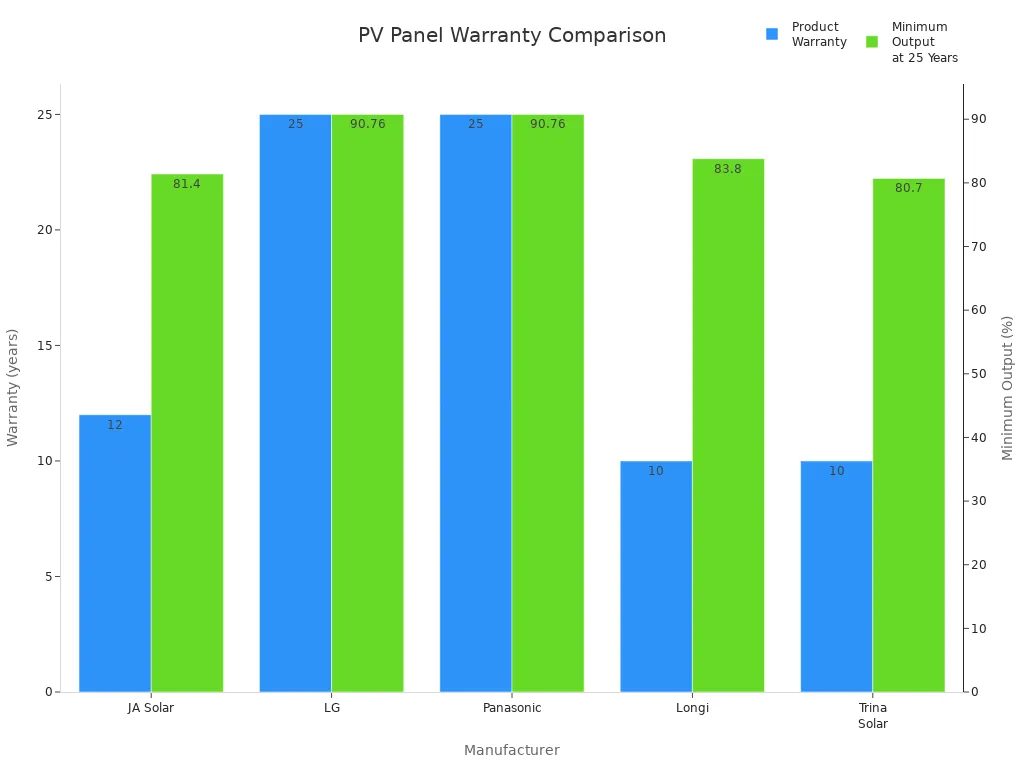
JA Solar PV panels offer competitive warranty coverage. While some brands provide longer product warranty periods, JA Solar’s performance warranty ensures reliable output for 25 years. You should review solar panel warranty terms before making your final choice. Strong warranty coverage protects you against unexpected issues and supports long-term solar savings.
Note: Always ask your installer for written warranty documentation. This ensures you understand your coverage and can claim support if needed.
Temperature Coefficient
You need to understand how temperature affects the performance of solar panels. The temperature coefficient measures how much panel efficiency drops as the temperature rises. JA Solar PV panels have a temperature coefficient of −0.52% per °C. This means that for every degree Celsius increase in temperature, the panel’s output decreases by 0.52%. In hot climates, this factor becomes critical for energy production.
JA Solar PV panels lose less efficiency in high temperatures compared to many polycrystalline models.
Monocrystalline panels, like those from JA Solar, maintain about 37% efficiency even when exposed to heat.
The type of solar technology you choose directly impacts your system’s real-world performance in different environments.
If you live in a region with frequent high temperatures, you should prioritize panels with a lower temperature coefficient. This choice helps you maximize energy output and ensures stable performance throughout the year.
Tip: Ask your installer to model your expected energy production based on local climate data. This step helps you select the best solar panels for your location.
N-Type Design
You gain significant advantages when you choose N-Type design for your solar panels. N-Type modules from JA Solar PV offer improved performance and longevity compared to traditional P-Type modules. The table below highlights key benefits:
Aspect | N-Type Module | P-Type Module |
|---|---|---|
First Year Degradation | < 1% | N/A |
Annual Degradation | < 0.4% | N/A |
Power Generation Gain | N/A | |
Temperature Coefficient | -0.3%/℃ | -0.35%/℃ |
Power Loss in Hot Weather | 1%-1.5% lower than P-Type | N/A |
Bifaciality | 80% | 70% |
Energy Gain from Bifaciality | 1%-1.5% under specific conditions | N/A |
Low Irradiance Gain | About 0.2% | N/A |
N-Type panels degrade less over time, so you enjoy higher energy yields and longer system life. You also benefit from better performance in hot weather and low-light conditions. Bifacial N-Type panels capture more reflected light, increasing total energy generation. These features make N-Type modules a smart investment for both residential and commercial solar projects.
Certifications
You want assurance that your solar panels meet international standards for safety and reliability. JA Solar PV panels hold several key certifications that demonstrate product quality:
Certification | Description |
|---|---|
IEC 61215 | Ensures performance and reliability of solar panels. |
IEC 61730 | Guarantees safety standards for photovoltaic modules. |
TÜV Rheinland’s Desert PV certification confirms that JA Solar panels withstand extreme environmental conditions.
These certifications give you confidence in your investment. They show that JA Solar PV panels have passed rigorous testing for durability, safety, and long-term performance. When you select certified panels, you reduce risks and ensure your solar system operates efficiently for years.
Note: Always verify certifications with your installer before purchasing. Certified panels protect your investment and simplify warranty claims.
Solar Technologies 2025
Cell Types
You face a dynamic landscape in solar cell technology in 2025. Manufacturers now offer advanced options that boost efficiency and lower costs. The most significant advancements include PERC, TOPCon, and N-type cells. You can compare these technologies using the table below:
Technology | Efficiency Range | Cost Competitiveness |
|---|---|---|
N-TOPCon | Increasingly competitive with PERC | |
PERC | 20% to 22% | Higher than N-TOPCon initially |
N-TOPCon cells deliver higher conversion efficiencies, which means you get more power from the same solar panel area. Improvements in manufacturing have made N-TOPCon cells more affordable, so you can access top-tier performance without breaking your budget. Bifacial N-TOPCon cells also enhance energy yield, making them ideal for large-scale solar installations. You benefit from a market shift, as leading manufacturers now produce over 70% of global solar panels using N-TOPCon technology. This trend ensures you receive panels that combine efficiency and cost-effectiveness.
Tip: When you select JA Solar PV panels, ask your supplier about the latest N-TOPCon models for maximum energy output.
Bifacial
You can unlock higher energy yields by choosing bifacial solar panels. These panels capture sunlight from both sides, increasing overall efficiency. Bifacial systems boost efficiency by 11% compared to traditional solar panels. Over 25 years, the newest bifacial panels can yield about 32% more energy. If you pair bifacial panels with solar tracking systems, productivity can rise by up to 27%. In diffuse light conditions, bifacial panels generate up to 30% more energy than monofacial panels.
Bifacial installations with single-axis trackers achieve the lowest Levelized Cost of Energy (LCOE) in over 93% of land areas.
One-axis tracker systems deliver high yields with only slightly higher costs.
Bifacial gain can reach up to 10% compared to monofacial panels in low ground albedo environments.
You should consider bifacial JA Solar PV panels for ground-mount or commercial projects. These panels help you maximize your solar investment and reduce long-term energy costs.
Double Glass
You gain extra durability and performance when you choose double glass solar panels. JA Solar PV panels with double glass construction pass industry tests that show significant energy yield increases. The table below highlights results from recent test arrays:
Test Array | Energy Yield Increase (%) |
|---|---|
No.1 | 15.44 |
No.1 | 23.34 |
No.1 | 20.25 |
Double glass panels resist moisture, dust, and mechanical stress better than standard panels. You benefit from longer service life and lower maintenance needs. These panels also maintain high output in harsh environments, making them suitable for utility-scale solar farms and challenging climates.
Note: Ask your installer about double glass JA Solar PV panels if you need robust performance and extended warranties.
Sustainability
You want your solar investment to support a cleaner planet. JA Solar leads the industry with a strong commitment to sustainability throughout the entire lifecycle of its products. The company’s approach covers manufacturing, logistics, and end-of-life management, ensuring that every step reduces environmental impact.
JA Solar’s “Green to Green” initiative creates a closed-loop system in manufacturing and supply chains. This program ensures that resources are reused and waste is minimized. The “Green to Growth” strategy encourages partners to adopt sustainability practices, while “Green to Great” focuses on benefiting local communities through responsible solar development.
You see real progress in JA Solar’s environmental goals. The company targets a 42% reduction in greenhouse gas emissions (Scope 1 and 2) by 2030 and aims for net-zero emissions by 2050. You benefit from these efforts because lower emissions in manufacturing mean a smaller carbon footprint for your solar installation.
JA Solar also invests in sustainable logistics. The company has electrified 96% of its onsite transport vehicles, reducing emissions from daily operations. Recycling plays a key role as well. JA Solar recycled 1.39 million sets of silicon wafer boxes and PE foam cartons, keeping valuable materials in use and out of landfills. Wastewater treatment projects further reduce pollutants and improve recycling rates, supporting a cleaner environment.
You gain from JA Solar’s technical innovations that drive sustainability in solar panel production:
Lower-emission FBR technology in polysilicon ingot production cuts emissions at the source.
Reduced silicon wafer thickness, now down to 125 µm, increases efficiency and saves resources.
Optimized silver use in metallization paste lowers the carbon footprint of each solar cell.
Busbarless metallization processes reduce soldering temperatures and carbon emissions.
High cell efficiency, such as the Bycium-class TOPCon cell at 25.6%, makes solar energy more competitive with fossil fuels.
Tip: When you choose JA Solar PV panels, you support a company that prioritizes sustainability and eco-friendly innovation. Your solar project becomes part of a global effort to reduce emissions and promote renewable energy.
You can trust that your solar panels come from a manufacturer that values both performance and environmental responsibility. This commitment to sustainability ensures that your investment delivers clean energy and lasting benefits for your community.
Solar Panel Hail Damage & Durability
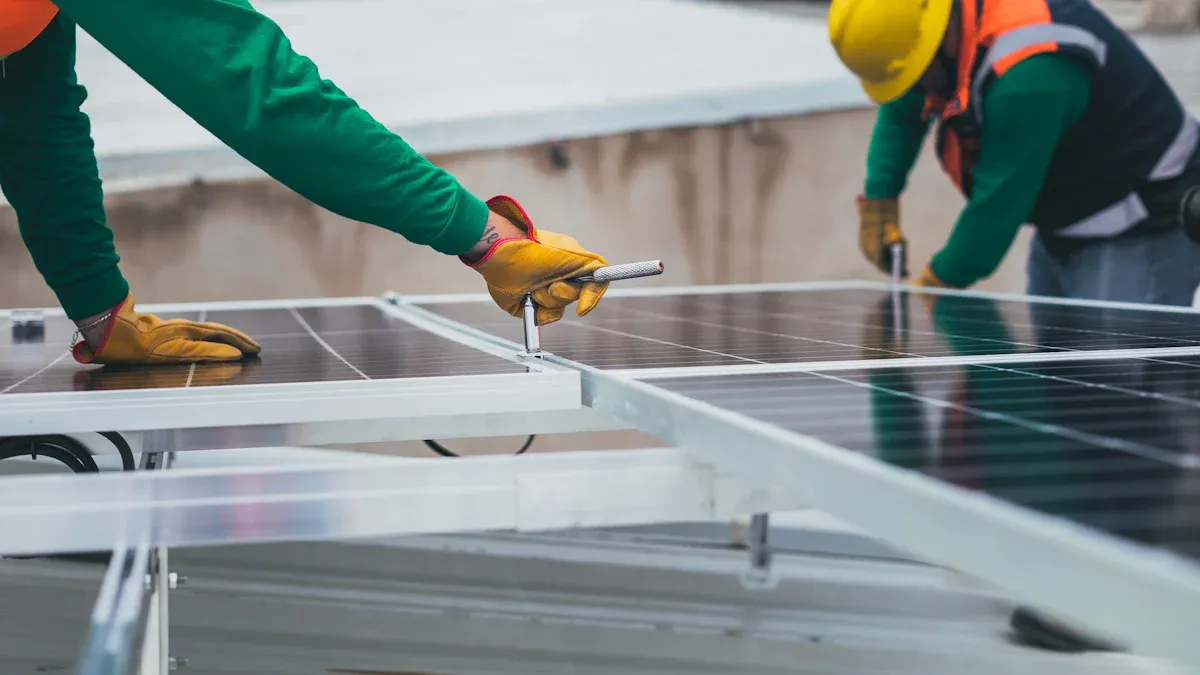
Impact Resistance
You need to know how well your solar panels can handle hail. Hail can strike with great force, and solar panel hail damage is a real concern for many homeowners and businesses. JA Solar PV panels undergo strict laboratory tests to measure their resistance to hail. These tests simulate the impact of large hailstones hitting the panels at high speeds. The table below shows the results of a typical hail durability test:
Test Type | Kinetic Energy (Joules) | Iceball Size (mm) | Terminal Velocity (m/s) |
|---|---|---|---|
Hail Durability Test | 45 | 30.7 |
You can see that these tests use iceballs much larger than what most storms produce. The panels must withstand hail impacts without cracking or losing performance. This level of testing ensures that your solar panels can survive even severe hail events. Many people believe that hail damage to solar panels happens easily, but these tests prove otherwise. Most modern panels, including those from JA Solar, resist hail damage far better than expected.
Certifications
Certifications give you confidence that your solar panels meet international standards for hail resistance. JA Solar PV panels carry certifications that specifically address hail and impact resistance. The table below outlines the main certifications and their testing standards:
Certification | Testing Standard |
|---|---|
Hail test | Ice ball in diameter 25 mm at 23 m/s, directed against 11 points of impact |
Static Mechanical Load (SML) test | Simulates real-world conditions, such as heavy snow accumulation and strong wind pressure, assessing the module structural integrity and ability to withstand sustained mechanical loads |
These certifications mean your panels have passed rigorous tests for hail impact and mechanical stress. You can trust that your solar system will keep working after hailstorms. Many myths about solar panel hail damage come from outdated information. Today’s panels, especially those from JA Solar, meet strict standards for hail resistance.
Note: Always check for these certifications before you buy. Certified panels protect your investment from hail and other weather hazards.
Real-World Performance
You want to know how JA Solar PV panels perform in real-world hail events. Studies show that these panels maintain high durability even after years of exposure to harsh weather, including hail. The table below highlights findings from research on solar PV systems under extreme weather:
Study Title | Key Findings |
|---|---|
Solar PV systems under weather extremes | Highlights challenges from extreme weather events on PV systems, emphasizing the need for resilience-oriented design and operational techniques. |
The average annual degradation rate of mono-crystalline PV modules in Egypt is 0.7%.
After 11 years, the average power degradation rate is around 1.55%.
After 20 years of exposure, the degradation rate increases to 1.75%, mainly due to encapsulant discoloration and delamination, not hail.
You can see that hail damage to solar panels rarely causes significant power loss. Most long-term degradation comes from other factors. JA Solar PV panels continue to deliver strong performance, even after repeated hail exposure. You should not worry about solar panel hail damage as long as you choose certified, high-quality panels and work with experienced installers.
Tip: Schedule regular inspections to catch any rare hail damage early. Most issues can be fixed quickly, keeping your solar system running at peak performance.
Installer Choice
Choosing the right installer for your solar project is essential. You want a team that understands JA Solar PV panels and delivers a quality installation that lasts. The installer’s expertise directly affects your system’s performance, safety, and warranty coverage.
Qualified Installers
You should always verify that your installer holds the proper qualifications. Licensed professionals follow strict standards and ensure safe installation of solar panels. Look for these credentials:
State or local agency licenses, which require proof of experience, education, and insurance.
Completion of a 10-hour OSHA safety course, a prerequisite for advanced solar certifications.
NABCEP certifications, such as PV Installation Professional, which demand specific training hours and documented project experience.
These qualifications show that your installer knows how to handle JA Solar PV panels and meets industry safety requirements. You protect your investment and reduce risks by choosing a certified team.
Tip: Ask your installer to provide copies of their licenses and certifications before starting your solar installation.
Experience
Installer experience with JA Solar PV panels makes a significant difference. Skilled professionals understand the unique features of these panels and follow manufacturer guidelines for mounting, wiring, and system integration. Experienced teams deliver better results and help you avoid common installation mistakes.
The table below outlines how installer experience influences warranty coverage:
Warranty Type | Coverage Description | Duration |
|---|---|---|
Manufacturer Warranty | Covers defects in materials or workmanship of the solar panels. | 10 to 30 years |
Installer Warranty | Covers workmanship of the installation, including roof holes, electrical connections. | 5 to 25 years |
You benefit from both manufacturer and installer warranties when you choose a qualified team. Proper installation ensures that your JA Solar PV panels perform as expected and that you maintain full warranty protection. If your installer lacks experience, you risk voiding warranties and facing costly repairs.
Angsun Solar Support
You gain an advantage by working with Angsun Solar. The company brings extensive experience in overseas solar projects and understands the requirements for quality installation. Angsun Solar’s team knows JA Solar PV panels inside and out. You receive expert guidance from project planning to final commissioning.
Angsun Solar supports you with:
Detailed site assessments and custom installation plans.
Coordination with local installers who meet strict qualification standards.
Ongoing technical support and warranty management.
You can trust Angsun Solar to deliver reliable solar solutions and maximize the value of your investment. Their expertise ensures that your panels operate efficiently and that your installation meets all safety and performance standards.
Note: Contact Angsun Solar for recommendations on qualified installers and to access their project management services.
Aesthetics
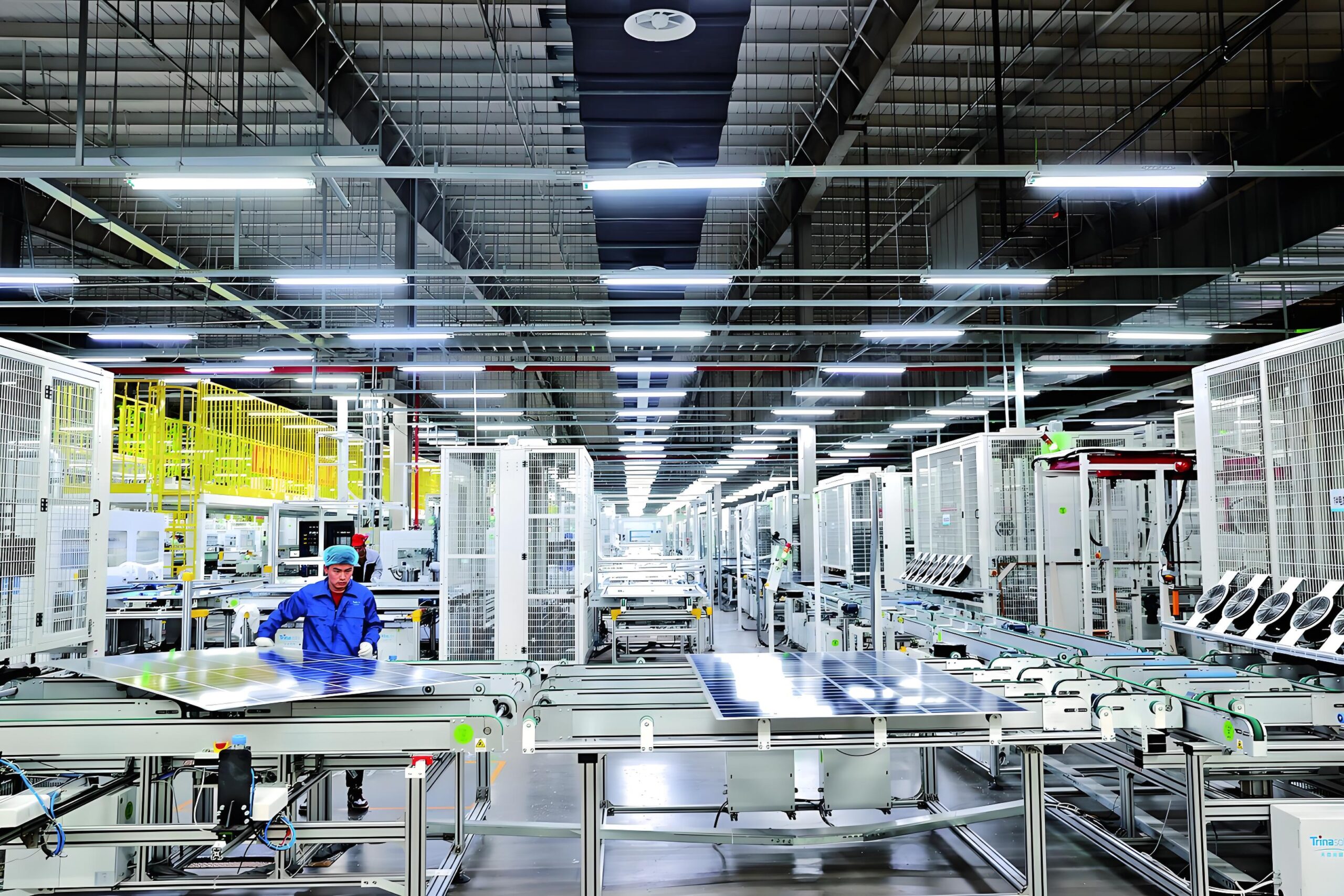
Full Black Panels
You want your solar installation to look as good as it performs. Full black JA Solar PV panels offer a sleek, uniform appearance that elevates the visual appeal of your property. These panels blend seamlessly with many roofing materials, including asphalt shingles, metal, and tile. You avoid the distraction of silver frames or white back sheets, which can break up the look of your roof. Instead, you get a cohesive and unobtrusive surface that complements contemporary architecture.
Full black panels create a modern, streamlined look.
They enhance curb appeal and reflect your commitment to sustainability.
Their design can increase property value by making your home or business more attractive to buyers.
You benefit from a solar system that looks integrated, not added on.
If you value aesthetics, full black JA Solar PV panels provide a solution that matches your style and boosts your property’s marketability.
Layout
You have flexibility when designing your solar panel layout. JA Solar PV panels come in various sizes and configurations, allowing you to optimize placement for both performance and appearance. You can work with your installer to create a pattern that fits your roof shape and avoids obstructions like chimneys or skylights. A well-planned layout ensures that your solar panels look organized and intentional.
Tip: Ask your installer for a digital rendering of your solar layout. This preview helps you visualize the final result and make adjustments before installation.
You can choose symmetrical rows for a classic look or staggered arrangements for unique roof shapes. The right layout maximizes sunlight exposure and maintains a clean, professional appearance.
Integration
You want your solar system to blend with your building’s design. JA Solar PV panels support integration with a wide range of architectural styles. You can match panel color and frame options to your roof for a unified look. Installers can use low-profile mounting hardware to keep panels close to the roof surface, reducing visual impact.
Integration Feature | Benefit |
|---|---|
Color-matched frames | Seamless transition between panel and roof |
Low-profile mounts | Minimal protrusion above roofline |
Custom array shapes | Fit complex roof designs |
You achieve a solar installation that complements your property, rather than competing with it. This thoughtful integration demonstrates attention to detail and enhances the overall impression of your home or business.
Note: A well-integrated solar system signals quality and care, making your property stand out in the neighborhood.
Decision Tips
Performance vs. Cost
You want to maximize your solar panel investment. Balancing performance, cost, and aesthetics helps you achieve the best results for your project. JA Solar panels offer strong efficiency ratings, reliable durability, and attractive pricing. The table below summarizes key criteria to consider when selecting panels:
Criteria | Evaluation |
|---|---|
Panel Efficiency | JA Solar panels have an average efficiency rating between 20% and 21%, with a maximum of 22.5%. These panels rank among the top five in the industry. |
Panel Durability | The panels show good resistance to extreme weather. Some models have below-average lifespan and efficiency degradation rates. |
Warranty Coverage | JA Solar provides a performance warranty of 25 to 30 years, which is above average. The equipment warranty lasts 12 years. |
Cost | JA Solar panels deliver high efficiency at a budget-friendly price. You pay a lower cost per watt compared to most competitors. |
Sustainability & Aesthetics | Some panels feature an all-black design with no visible grid lines. This appeals to aesthetic preferences. Production in China may raise sustainability concerns. |
You should compare these factors to find the right balance for your needs. High-efficiency panels increase your return on investment, especially if your roof space is limited. Lower-cost panels help you stay within budget while still achieving strong solar performance. If aesthetics matter, choose all-black panels for a sleek look.
Tip: Use a simple spreadsheet to compare panel models by efficiency, cost, warranty, and appearance. This helps you visualize your options and make informed decisions.
Expert Advice
You benefit from expert guidance when planning your solar project. Professional installers understand the unique features of JA Solar panels and can recommend the best solutions for your site. You should request detailed quotes that include all equipment, labor, and warranty terms. Ask your installer to model your expected energy output and return on investment. This ensures you select panels that meet your energy goals and maximize your solar panel investment.
You can reach out to Angsun Solar for personalized support. Their team offers technical expertise and project management for both residential and commercial installations. Contact Angsun Solar by email at sales@angsunsolar.com or by WhatsApp/Phone at +86 18021425296. You receive clear answers to your questions and tailored recommendations for your solar project.
Note: Expert consultation helps you avoid costly mistakes and ensures your solar panels deliver reliable performance for years.
Next Steps
You should take action to secure the best solar solution for your property. Follow these steps to move forward:
Assess your roof space, orientation, and age.
Define your energy goals and budget.
Compare JA Solar panels by efficiency, durability, warranty, and aesthetics.
Request quotes from qualified installers.
Consult with Angsun Solar for expert advice and project support.
Review your return on investment projections before making a final decision.
You improve your solar panel investment by following a structured approach. Careful planning and expert support help you achieve strong performance, attractive aesthetics, and long-term savings.
🚀 Ready to start your solar journey? Contact Angsun Solar today for a custom quote and professional guidance.
You can select the best JA Solar PV panels by following a clear process.
Assess your roof type and condition.
Compare efficiency and durability for each solar option.
-
Choose qualified installers with experience in solar projects.
Contact Angsun solar for expert advice and a custom plan. You will maximize your investment and enjoy reliable solar energy for years.
FAQ
What makes JA Solar PV panels a good choice for my project?
JA Solar PV panels offer high efficiency, strong durability, and reliable warranties. You benefit from advanced technology and a wide range of options for residential, commercial, and utility-scale installations.
How long do JA Solar PV panels last?
You can expect JA Solar PV panels to last 25 to 30 years. The panels maintain strong performance with minimal degradation, supported by long-term product and performance warranties.
Are JA Solar PV panels suitable for all roof types?
You can install JA Solar PV panels on most roof types, including tile, metal, and flat roofs. Your installer will recommend the best mounting system for your specific roof structure and material.
What kind of maintenance do JA Solar PV panels require?
You need minimal maintenance for JA Solar PV panels. Cleaning the panels a few times a year and scheduling regular inspections help ensure optimal performance and longevity.
How do JA Solar PV panels perform in extreme weather?
JA Solar PV panels undergo rigorous testing for hail, wind, and temperature extremes. You can trust these panels to withstand harsh conditions and deliver reliable energy output year-round.
Can I use JA Solar PV panels for off-grid systems?
You can use JA Solar PV panels in both grid-tied and off-grid systems. The panels work well with battery storage and hybrid inverters, making them suitable for remote locations or backup power.
What certifications do JA Solar PV panels have?
JA Solar PV panels hold international certifications, including IEC 61215 and IEC 61730. These certifications confirm the panels meet strict safety and performance standards.
Will installing JA Solar PV panels increase my property value?
You may see an increase in property value after installing JA Solar PV panels. Many buyers value energy efficiency and lower utility costs, making solar-equipped properties more attractive.
